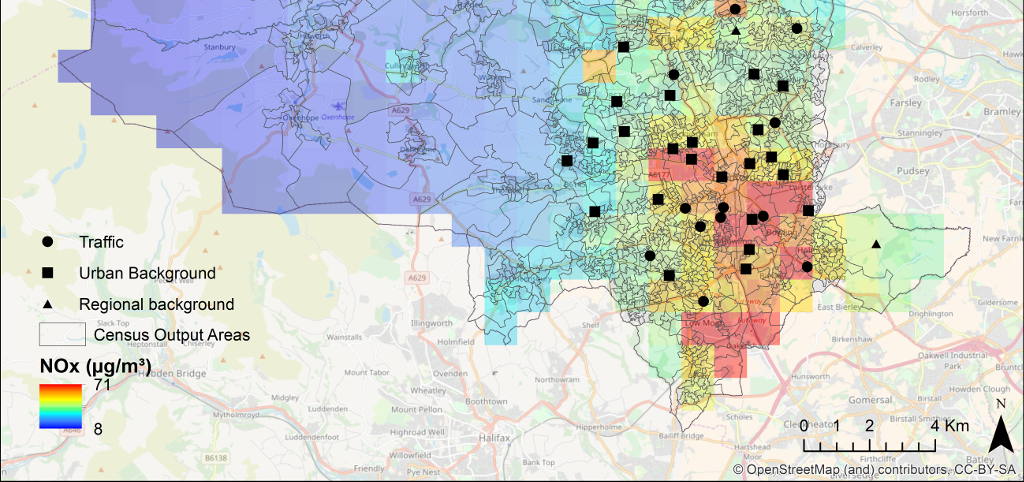A Study in the UK Attributes Up to 38% of Annual Childhood Asthma Cases to Air Pollution
New research conducted in Bradford also highlights that traffic-related air pollution could be specifically responsible for up to 24% of the total cases
27.03.2018
An international team of researchers of the Barcelona Institute for Global Health (ISGlobal) —a centre supported by the ”la Caixa Foundation”—, and the Institute for Transport Studies at Leeds has used a newly developed model to assess the impact exposure to nitrogen oxides –gases that make up air pollution– has on the development of childhood asthma.
Their study, published today in Environment International, used a model that knits together four distinct models of traffic, emissions, atmospheric dispersion and health impact assessments in Bradford. This allowed the researchers to chart the full chain of impact —from the source of air pollution through the pathways in which it impacts children’s health .
The results indicate that up to 38% of all annual childhood asthma cases in Bradford may be attributable to air pollution . More specifically, the model estimates showed that 12% of the annual childhood asthma cases would be attributable to traffic related air pollution. “However, we knew our model was underestimating the traffic related fraction of air pollution. When we adjusted our results using actual measurements of air pollutants we saw that up to 24% of the annual cases could be attibutable to traffic related air pollution ”, says Mark Nieuwenhuijsen, Director of the Urban Planning, Environment and Health Initiative at ISGlobal.
Study lead author Haneen Khreis, researcher at ISGlobal and at the Institute for Transport Studies at Leeds, said: “ Overall rates of childhood asthma cases in Bradford are higher than the UK average as were emergency hospital admissions for asthmatic children under 16 years of age. ”.
“Our team’s previous research has shown that children exposed to high levels of traffic-related air pollution have a higher risk of developing asthma . Quantifying the number of childhood asthma cases that are directly attributable to traffic-related air pollution has not been done in the past and as we show now, a significant portion of cases is largely preventable.”
She added: “Our work demonstrates that while popular initiatives such as stopping vehicles from idling outside schools or providing walking routes away from roads are important, proposed solutions to mitigate traffic pollution shouldn’t be restricted to localised areas. New policies aimed at reducing the effects of traffic-related air pollution need to target each link in the full chain of events —from traffic volume and type, to exhaust and non-exhaust emissions, to dispersion to exposure.”
Bradford is the 6th largest city in the UK, with a multi-ethnic population of more than 530,000 people. At the same time, it is also among the 10% most deprived local authorities in the UK. The models used in the study allowed the team to chart how much air pollution is present in the city, and how much of that can be traced back to road traffic.
Study co-author Mark Nieuwenhuijsen said: “Cases of childhood asthma have been steadily increasing since the 1950s. Future progress with childhood asthma requires a focus beyond controlling and treating the disease toward asthma prevention starting with reducing traffic related air pollution.”
This study is part of ongoing work in Bradford assessing emissions and air quality profile in the region and the associated childhood health effects and impacts on the community. The research team is now preparing a health impact assessment of air pollution and asthma at European level.
John Wright, Director of the Bradford Institute for Health Research and chief investigator of the Born in Bradford study, said: “This important study adds to the overwhelming evidence that air pollution is harming our children. The air in our cities has become a tragedy of the commons whereby a common good is being poisoned by collective neglect . The good news is that we can all save lives by driving less and using cleaner fuels.”
Reference
Khreis M., de Hoogh K., and Nieuwenhuijsen MJ. Full-Chain Health Impact Assessment of Traffic-Related Air Pollution and Childhood Asthma. Environment International, March 2018.



